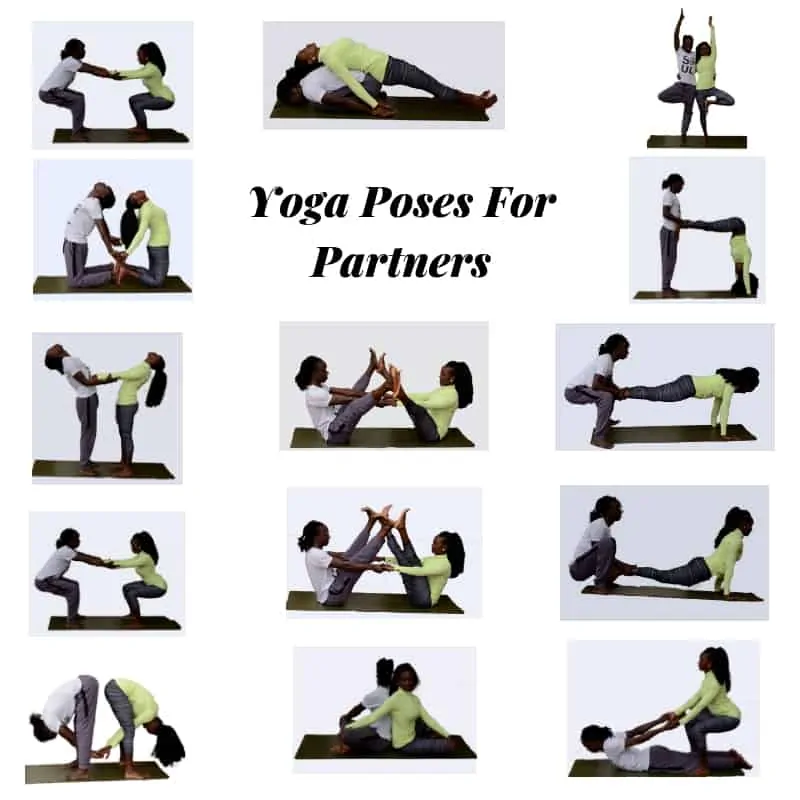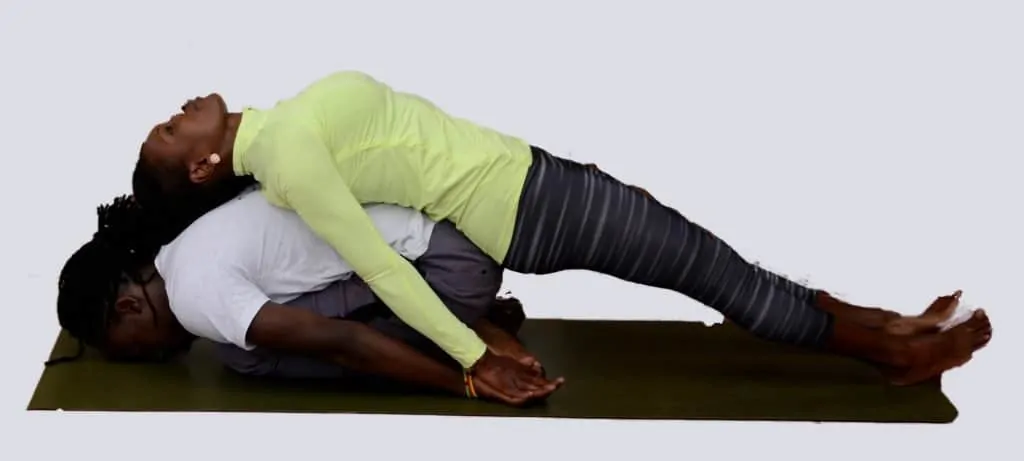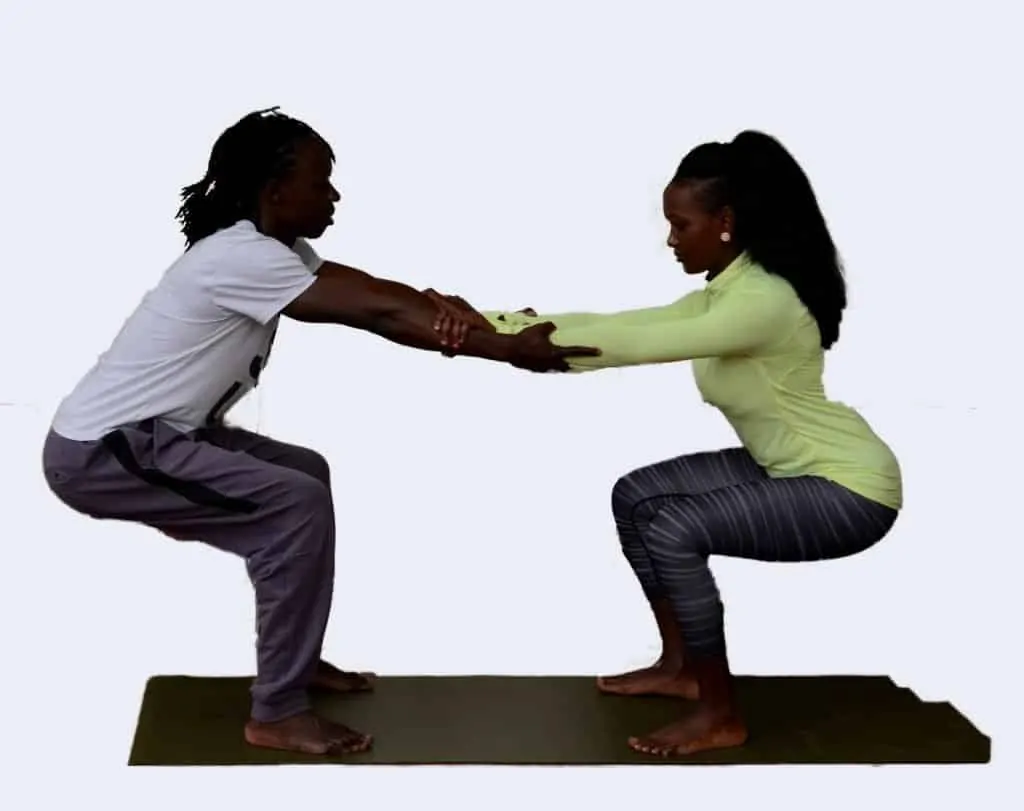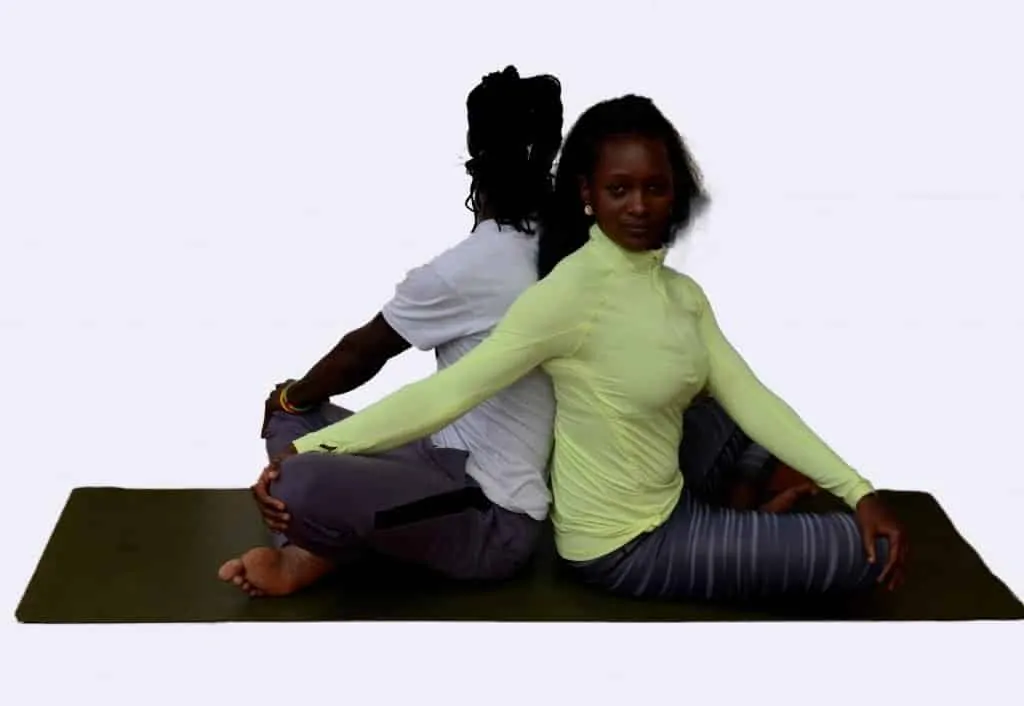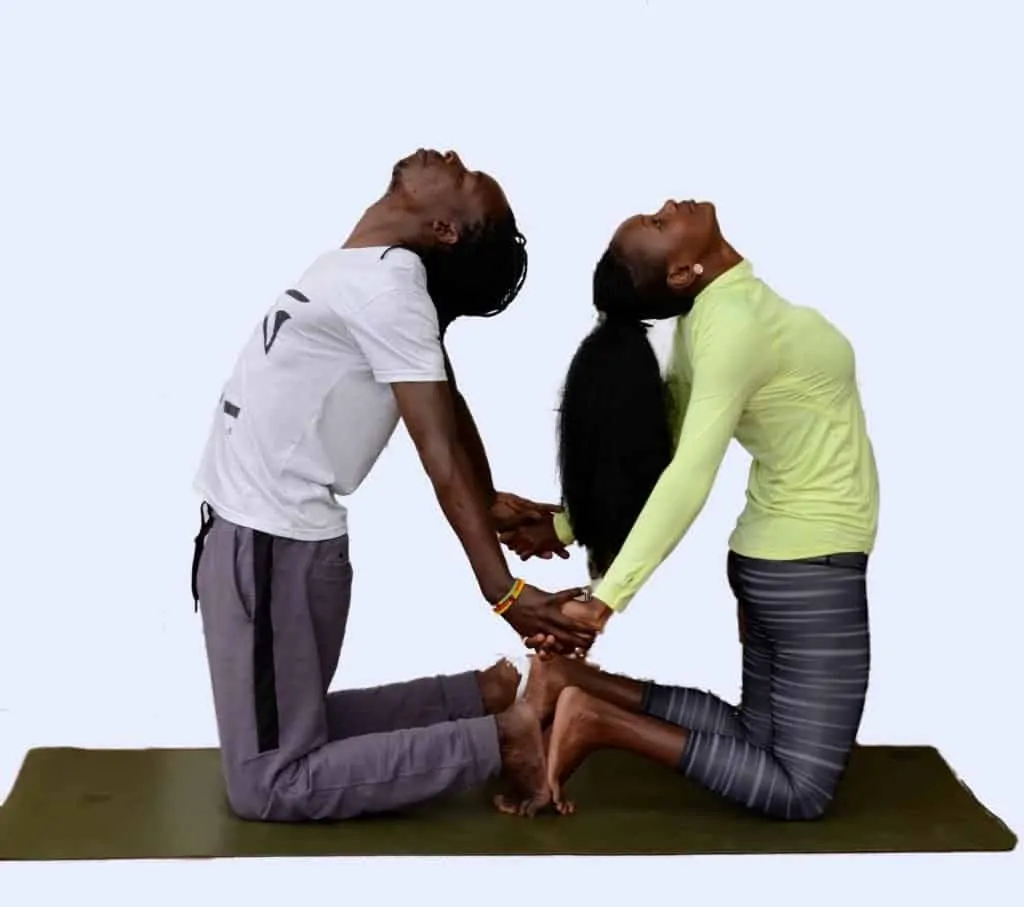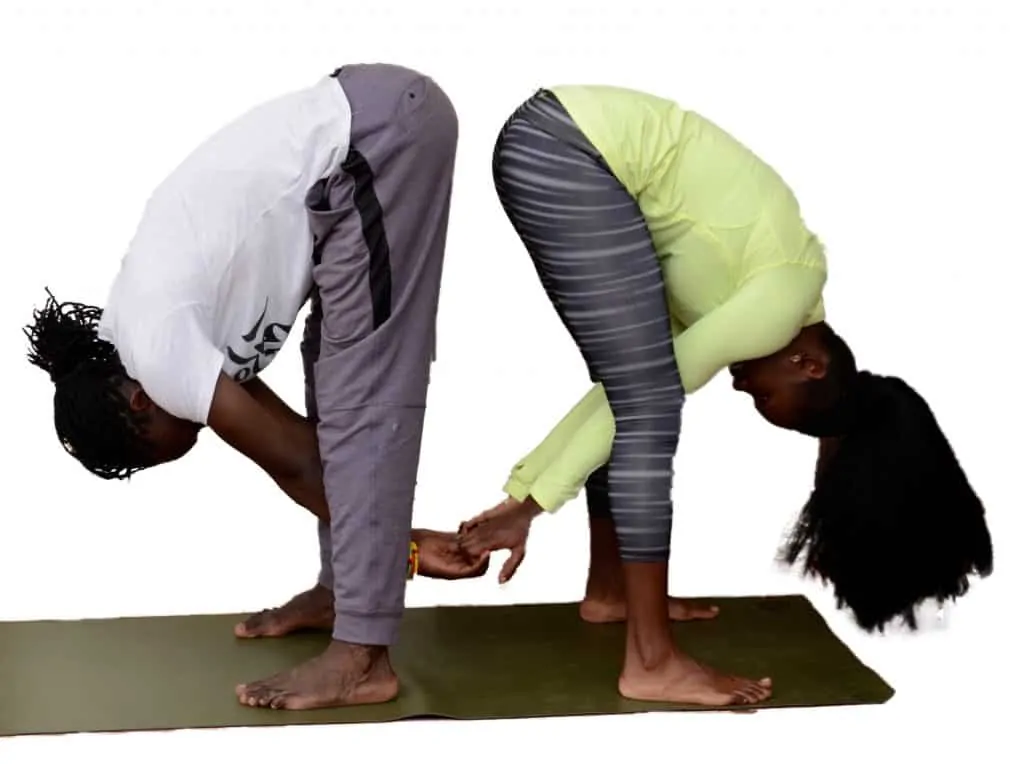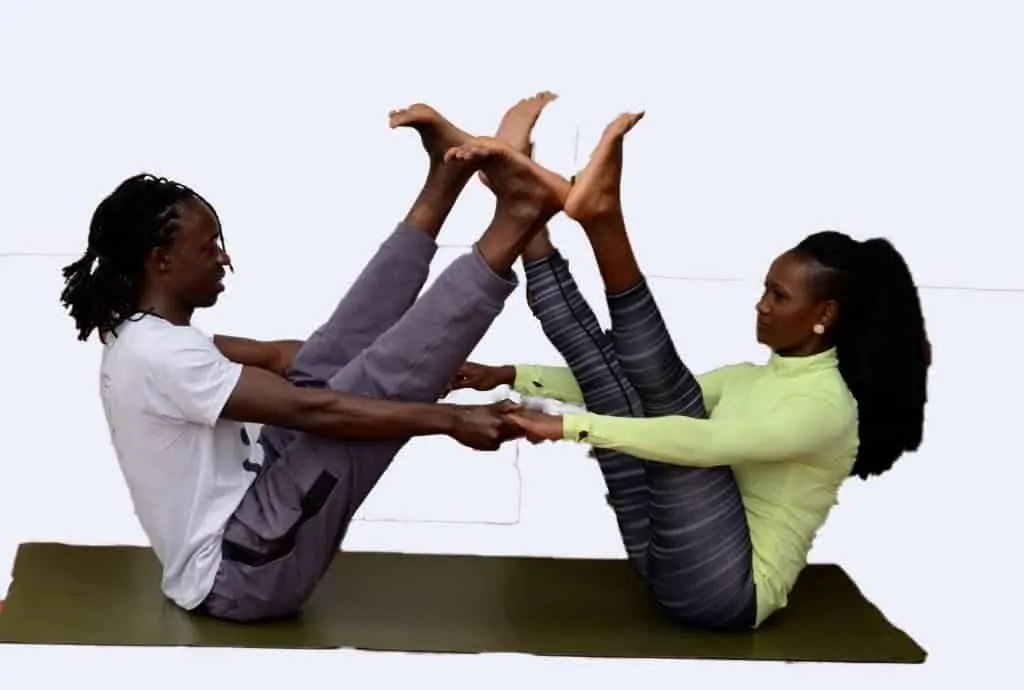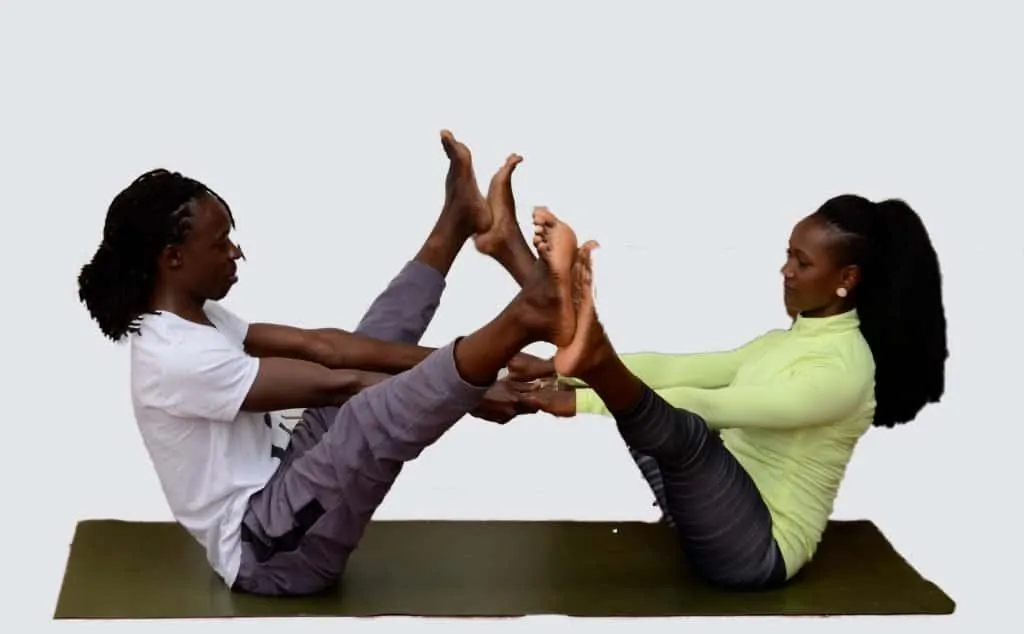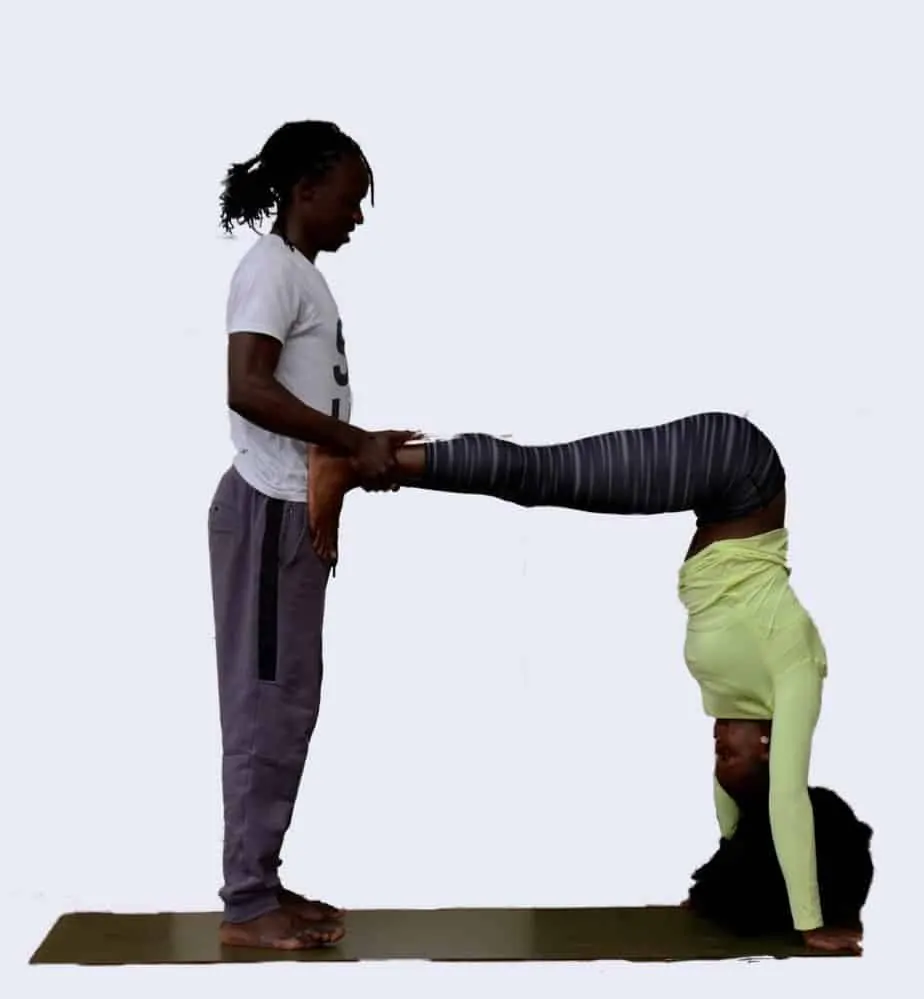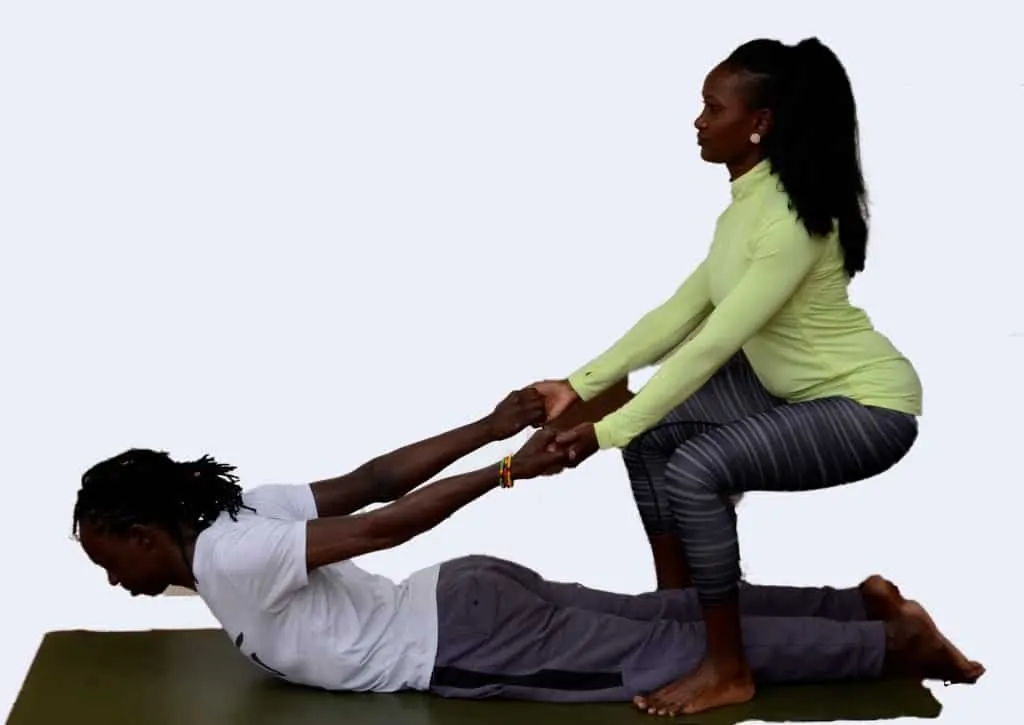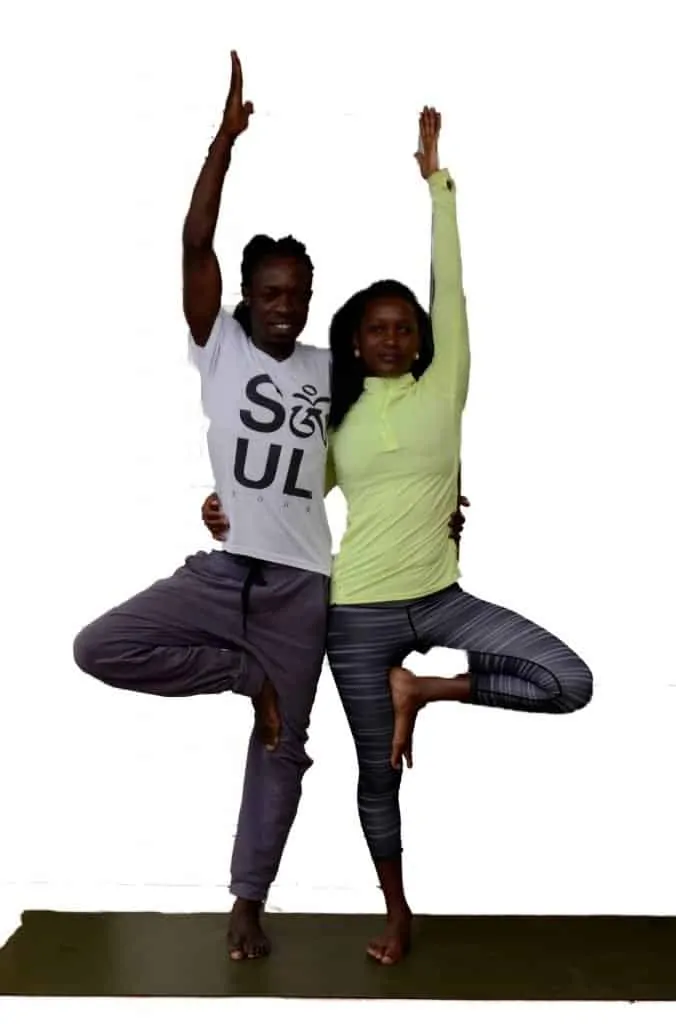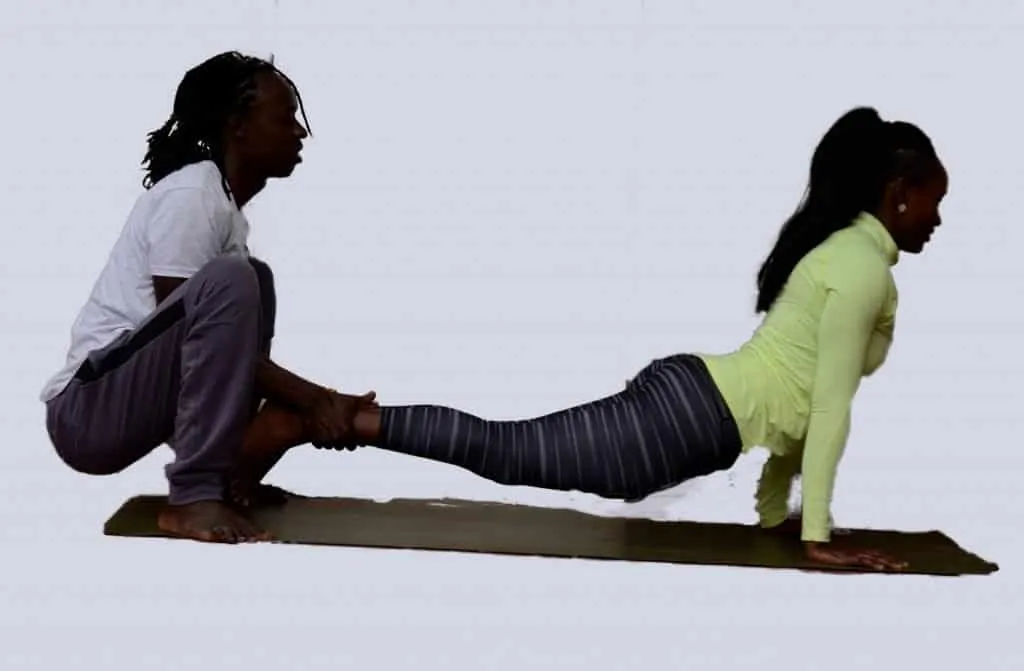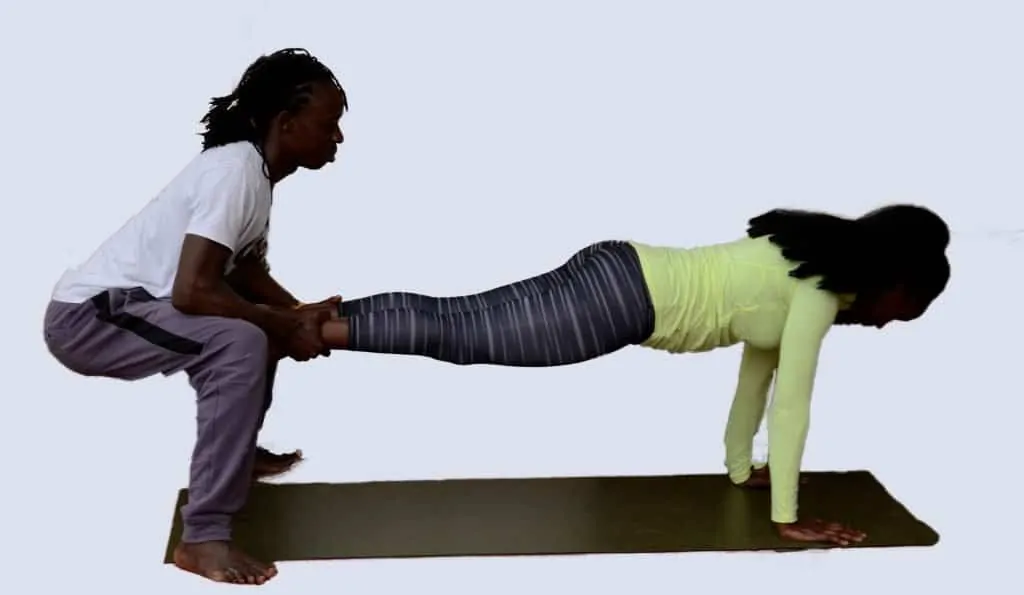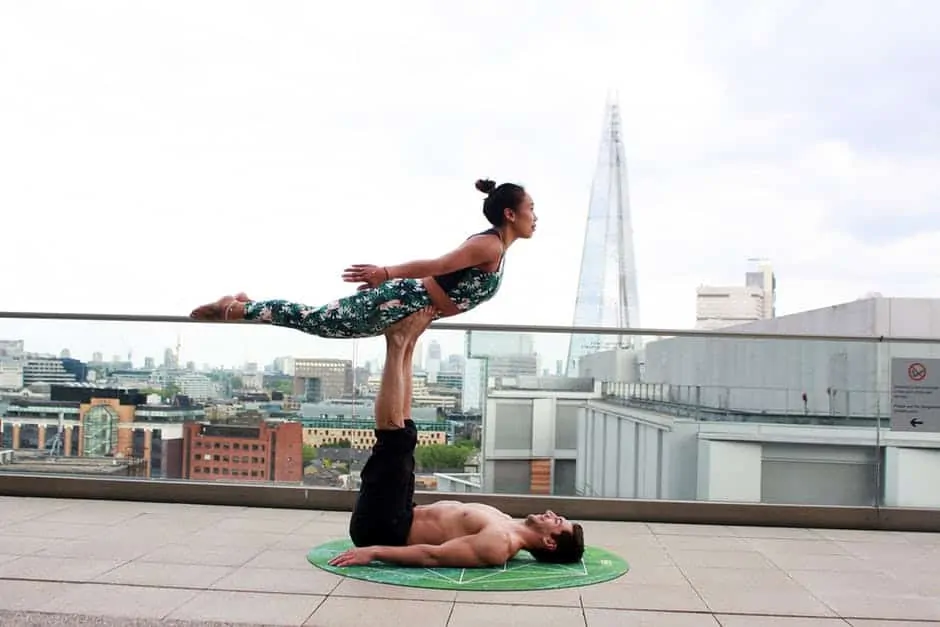Life can become fast paced – with so much to do and seemingly limited time. Often, relationships with our loved ones suffer the most as we struggle to find time to spend with them. Even when we do get the time, it may feel like we are not connecting well enough.
While going to movies together, sharing a meal, catching up over drinks or over phone, and giving gifts etc. are great ways to bond and reconnect with loved ones, doing partner yoga offers deeper emotional, physical, and energetic bonding.
Benefits of Partner Yoga
Partner yoga improves verbal and kinesthetic communication and promotes trust. When doing partner poses, communicating effectively is essential for building trust and ensuring safety. Open communication on the mat encourages open communication in your day to day life. In a world where we spend a lot of time communicating over gadgets, partner yoga enables for real human touch and spending actual “Facetime” with your loved ones.
“The more the merrier” goes for parties as well as yoga. Practicing yoga with a partner can be more fun than practicing alone. It brings a sense of light heartedness and laughter in your yoga practice which promotes flow of energy throughout the body. Besides, you motivate and support each other to get deeper into postures.
You can practice partner yoga with your spouse, friend, a family member or any other person that is close to you.
Get Grounded Together
Before beginning your yoga for partners practice, it is important that both of you are present and grounded. You can get centered by practicing meditation or doing breathing exercises together for a few minutes.
You may adopt synchronized breathing or yin-yang breathing. With synchronized breathing you both inhale and exhale at the same time. On the other hand, yin-yang breathing is when one partner inhales as the other exhales, and vice versa.
For couples, the grounding procedure can be more intimate. For example, by maintaining eye contact as you breath in synchrony, or placing your hand on your partners heart center and vice versa as you sit in stillness and listen to each other’s breathing and heart beat.
14 Partner Yoga Poses for Stronger Relationships.
Yoga for partners can include a combination of two different poses; where one person does one of the poses, and the other does the other pose. Or, both of you can do the same pose
Some partner yoga poses overlap with Acroyoga. Acroyoga is an advanced type of yoga where one partner serves as the base and the other as the flier. The base holds the flier in an elevated position from where the flier can do different yoga poses. Acroyoga requires a high level of strength and flexibility on the part of both partners. It is best to try it out under the guidance of an instructor. Therefore, you may want to attend an acroyoga class or workshop with your partner.
The list below incorporates 14 beginner and intermediate level partner yoga poses and one acroyoga pose at the end.
1. Child’s Pose + Fish Pose
In this partner pose, you will take child’s pose and your partner will rest on your back in fish pose. The partner on child’s pose enjoys a deep hip opening and release on the back, as the partner on top offers a gentle push for them to get deeper into the child’s pose. On the other hand, the partner in the fish pose, gets support on the back allowing the spine to arch naturally and chest to open. Both poses improve blood circulation to the brain which promotes stress relieve and calmness.
Child’s Pose+Fish Pose
Instructions
Partner 1:
- Come to your fours, bring your toes and knees to touch and sit back on your heels.
- Rest your chest on your thighs and head on the ground.
- Take your arms beside your body, palms facing backwards.
Partner 2:
- Sit behind partner 1, seating bones beside your toes, legs extended straight in front of you and palms besides your hips.
- Press down with your hands and lift your seating bones off the floor.
- Lean back to rest on your partner’s back.
- Walk your body upwards until your sacrum is in line with the sacrum of your partner.
- You may either straighten your legs or keep your knees bent.
- Release your hands beside your body.
Both partners:
- Come to a synchronized breathing pattern and hold the pose for 5-10 breaths.
- Come out of the pose and switch positions.
2. Partner Half Waist Wheel Pose
In the partner half waist wheel pose, both partners get into an intermediate level back bend that strengthens the back, opens the chest, and stretches and lengthens the entire front of the body. You leverage on each other’s support for balance to be able to get deeper into the backbend and hold the asana longer.
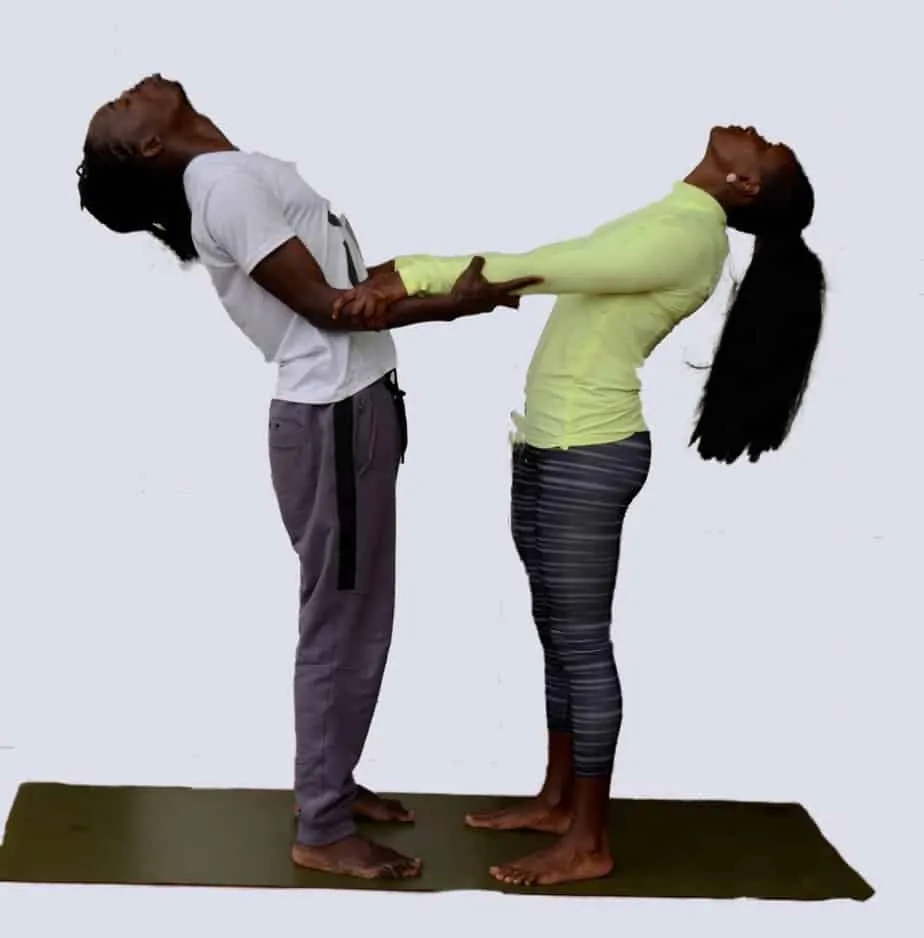
Partner Half Waist Wheel Pose
Instructions
- Come to standing in Tadasana facing each other, about 2-3 feet apart.
- Straighten your hands towards each other and hold each other’s arms.
- Ground your feet down, lengthen your torso and take a backbend.
- Use each other’s arms for support to get as deep on the backbend as possible.
- Drop your head towards the back.
- Hold for 5-10 breaths.
3. Partner Chair Pose
The chair pose is an energizing and invigorating asana that strengthens and stretches the entire lower body. As you hold on to your partner’s arms, you get strength to sit lower into your chair and to feel through the strong sensations on your thighs.
Partner Chair Pose
Instructions
- Stand facing each other, 2-3 feet apart.
- Reach your hands forward towards each other and hold on to your partner’s arms.
- Press the four corners of your feet down as you sit back as you would when taking a seat. (The goal is to get your hips inline with the knees.)
- Drop your shoulders down, your shoulder blades towards each other, and your chest outwards.
- Look at each other and breath in synchrony.
- Hold for 5-10 breaths.
4. Partner Seated Twist
The partner seated twist offers you support to elongate and twist your torso promoting a stronger back and rinsing out toxins in the abdominal organs.
Partner Seated Twist
Instructions
- Come to sitting, your backs against each other with legs crossed. Ensure your sacrums are touching.
- Lengthen your torso and twist from the base of your waist to face backwards.
- Reach your right hand backwards to rest on the left knee of your partner, and your left hand to rest on your right knee.
- Gaze past your right shoulder.
- Hold for 5-10 breaths.
- Come back to center and switch sides.
5. Partner Camel Pose
The partner camel pose offers you the benefits of a backbend including strengthening he back and opening the chest and shoulders. It also lengthens and strengthens the quadriceps.
Partner Camel Pose
Instructions
- Kneel down facing opposite directions.
- Bring the soles of your feet to touch.
- Lengthen your torsos and reach your hands backwards towards your partner.
- Hold each others hands.
- Take a backbend and drop your heads downwards and backwards.
- Hold for 5-10 breaths.
6. Partner Standing Forward Bend
In the forward bend, your lower back releases as the calves, hamstrings and glutes lengthen. It also releases tension off the lower back and neck. The partner forward bend is calming to the nervous systems and energetically grounding.
Instructions
- Stand with your feet hip-width apart, 2-3 feet away from each other, facing opposite directions.
- From the hip joint, hinge forward and bring your chest and face as close to your thighs and shins as possible.
- Reach your hands backwards through the space between your legs.
- Hold each other’s hands as your draw your chest closer to the thighs.
- Allow your head to hang from the base of your neck so that the crown of your head is pointing downwards.
- Keep the four corners of your feet grounded down and your knees micro bent.
- Hold for 5-10 breaths.
7. Partner Boat Pose
The boat pose is a primarily a core strengthening asana. As you do it with the support of your partner, you gain better balance and you are able to hold it longer. It also stretches the calves, hamstrings, and back while opening chest and shoulders.
Partner Boat Pose
Instructions
- Sit on the ground facing each other.
- Bend your knees and bring your big toes to touch.
- Straighten your arms forward from the outside of your knees.
- Hold each other’s hands.
- Partner 1, slightly lift your right foot off the ground and partner 2, lift your left foot and bring the soles of your feet to touch.
- Keep the soles of your feet touching and lift your legs up, toes pointing towards the ceiling.
- Repeat step 4 and 5 for the other side.
- Keep gently pressing your heels against each other and holding onto each other’s hands for balance.
- Your backs may tend to round, keep the spine straight by dropping your shoulders and shoulder blades downwards, tucking your tailbone inwards and lifting your chest.
- Keep your neck straight and head facing up.
- Hold for 5-10 breaths.
8. Partner Upward Facing Wide Angle
The upward facing wide angle pose stretches and lengthens the entire backside of the body while building core strength and opening the chest. It promotes overall body flexibility and balance. With the support of your partner, you can open your feet wide getting a deeper access to the groin and hamstrings.
Partner Upward Facing Wide Angle
Instructions
- Assume a seated position facing each other with your knees bent and hip-width apart.
- From the inside of your knees, reach your hands forward and hold each other’s hands.
- Partner 1, slightly lift your right foot off the ground and partner 2, lift your left foot and bring your soles to touch.
- Keep the soles of your feet touching and lift your legs up, toes pointing towards the ceiling.
- Repeat step 4 and 5 for the other side.
- Keep gently pressing your heels against each other and holding onto each other’s hands for balance.
- Open your feet as wide as possible.
- Maintain a straight back, neck straight and look up.
- Hold for 5-10 breaths.
9. Mountain Pose + Handstand
Technically, in this pose one partner is supporting the other to do a handstand. The one standing enjoys the benefits of Tadasana including straight spine and improved body posture, while the one on the handstand enjoys the benefits of an inversion including increased blood flow to the head and calming effect on the nervous system. The handstand also strengthens the biceps, triceps, shoulders, upper back, and core.
Mountain Pose+Handstand
Instructions
Partner 1:
- Take a downward facing dog with your hands shoulder-width apart, palms firmly pressing down and fingers spread.
Partner 2:
- Stand in tadasana a foot or two behind partner 1’s feet.
- Squat down and grab partner 1’s feet by the ankles.
- Gently straighten your knees to come to standing as you lift partner 1’s legs until their lower body and upper body form a right ankle.
- You may need to walk a few inches forward or backwards to find a comfortable distance between you and your partner.
Partner 1:
- In the handstand, keep your biceps and triceps active by internally rotating your hands. Micro bend the elbows to avoid hyperextending them.
- Draw your shoulders away from your ears.
- Engage your core.
- Drop your head so that the crown is pointing down and you are gazing at your partner’s shins.
Both partners:
- Hold for 5-10 breaths and switch positions
- To get out of the posture, partner 2 assume a squatting position and slowly lower partner 1’s feet down.
- Partner 1 rest in child’s pose for a few breaths to allow distribution of blood throughout the body.
10. Chair Pose + Locust Pose
This combination of partner poses offers you a full body workout. The locust pose opens the chest while strengthening the back on the backbend. Additionally, as you lie on your belly, the ground gently massages the abdominal organs promoting digestion and detoxification. On the other hand, the chair pose strengthens and stretches the lower body muscles while activating core muscles.
Chair Pose + Locust Pose
Instructions
- Partner 1: Lie on your belly, feet hip-width apart and hands resting beside your body.
- Partner 2: Come to standing with your legs straddled midway across partner 1’s thighs. Bend your knees to chair pose.
- Partner 1: Lift your hands upwards and backwards and the chest off the ground to take a backbend.
- Partner 2: Hold partner 1’s hands and help him to lift a little more on the backbend.
- Hold your positions for 5-10 breaths.
- Release and switch positions.
11. Twin Tree
The twin tree pose is a fun and easy to do pose that promotes balance. You lean on each others sturdiness for stability.
Twin Tree Pose
Instructions
- Come to standing hip to hip beside each other.
- Ground down the foot of the leg that is beside your partner.
- Lift the outer leg and place the sole of your foot on the inner thigh of the standing leg.
- Take hand that is beside your partner and wrap it around their back.
- Lift the outer hand up towards the ceiling to meet and wrap the fingers of your partner’s hand.
- Keep your torso lengthened and neck straight.
- Look ahead and hold the pose for 5-10 breaths.
- Switch sides.
- To switch sides, turn and face backwards so that the side of the hip that was outside is now beside your partner’s hip.
12. Yogi Squat + Cobra Pose
On the yogi squat, your hips, glutes, inner thighs and lower back lengthen and open. When in cobra pose, the chest opens, abdominal organs get a massage while the back strengthens.
Yogi Squat + Cobra Pose
Instructions
Partner 1:
- Lie down on your belly, feet hip-width apart.
- Place your hands under your shoulders.
- Press your palms down and lift your chest off the ground. (Belly and the rest of the body remain down.)
- Toes should be flexed such that the tops of the feet are on the ground.
- Look forward.
Partner 2:
- Stand behind partner 1’s feet, feet wider than hip-width apart.
- Squat down to a level where your butt is lower than knees and floating a few inches above the ground.
- Slide your palms under partner 1’s top of the feet.
- Squeeze your shoulder blades towards each other and lift your chest.
- Lengthen your neck and gaze forward.
Partner 1&2:
- Synchronize your breathing and hold your poses for 5-10 breaths.
- Release and switch positions.
13. Chair pose + Plank pose
Both the chair pose and plank pose are strengthening and invigorating full body poses. Both poses will push you out of your comfort zones. You and your partner will need to find your own strength so that you can be able to offer support to each other.
Chair Pose+Plank Pose
Instructions
Partner 1:
- Come to table top pose – wrists under shoulders and knees under hips.
- Lift your knees off the ground and straighten your legs. Flex your toes so that you are resting on the balls of the feet and the heel is pointing outwards.
- Engage your thigh muscles by hugging in from the skin to the muscle to the bone.
- Tighten your core and drop your tailbone.
- Draw your shoulder blades towards each other. Elongate your neck and look at the space between your thumbs.
Partner 2:
- Stand behind partner 1’s feet, feet hip width apart.
- Squat down until your knees and hips are in line.
- Reach your hands down and grab partner 1’s feet at the ankles.
- Lean back into your squat and lift partner 1’s feet of the ground to a level where the entire body is in a straight line.
- You may rest your elbows on the thighs for better balance.
Partner 1&2:
- Synchronize your breathing and hold your poses for 5-10 breaths.
- Release and switch positions.
14. High Flying Airplane Pose
The high flying airplane pose offers the flying partner a lengthening of the entire body and opening of the chest. It offers the base partner strengthening of the core and leg muscles The essence of acroyoga poses is for both partners to let go their control and lean on each other for support and balance. It takes trusting each other. The flier releases the weight of their body to the base.
High Flying Airplane pose
Instructions
- Partner 1 lie on your back with knees bent pointing up.
- Partner 2 stand in front of partner 1’s feet.
- Partner 1 place the soles of your feet on the front of partner 1’s thighs at the hip joint. Reach your hands up towards the ceiling.
- Partner 2 lean your torso forward and hold onto partner 1’s hands.
- Partner 1 straighten your hands and legs as you lift partner 1 up.
- Partner 2 engage your core and lengthen your entire body. Your feet should be wider than hip width apart and toes pointing backwards. Lengthen your torso and lift your chest up. You may keep your hands pressing on to partner 1’s hands or straighten them beside your body. Look ahead and come to synchronized breathing with partner 1.
- Hold for 5-10 breaths
To get out of the pose, partner 1 bend your knees and lower partner 2 to a level where they can place their feet on the ground.
Conclusion
End your partner yoga session by lying down next to each other in corpse pose. You may hold hands and listen to a relaxing savasana meditation together. Or you could offer each other a gentle head, shoulders and back rub to release tension and stimulate the body to release endorphins.
While doing yoga alone has its pluses such as you are able to focus on your practice and become more self-aware, partner yoga has its perks too. You get to spend quality time with a loved one and it can be the motivation you need to do your practice on those lazy days. You establish connection and trust with each other, and you both end the practice feeling invigorated and restored.
You may do partner yoga at home if you have at least an intermediate level understanding and experience in yoga. Otherwise, it is best to attend partner yoga class or workshop near you. The instructor will guide you through the poses while ensuring your safety. I must emphasis that for beginners in acroyoga, it is best to attend a class or workshop or hire the services of a personal instructor to prevent accidents and injuries.
